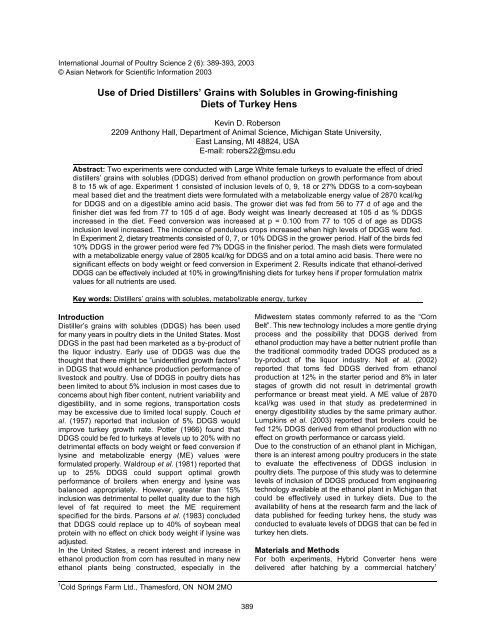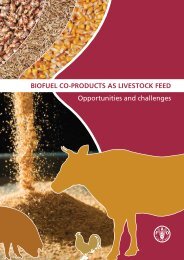Distillers Grains Feeding Recommendations. - Distillers Grains By ...
Distillers Grains Feeding Recommendations. - Distillers Grains By ...
Distillers Grains Feeding Recommendations. - Distillers Grains By ...
You also want an ePaper? Increase the reach of your titles
YUMPU automatically turns print PDFs into web optimized ePapers that Google loves.
International Journal of Poultry Science 2 (6): 389-393, 2003© Asian Network for Scientific Information 2003Use of Dried <strong>Distillers</strong>’ <strong>Grains</strong> with Solubles in Growing-finishingDiets of Turkey HensKevin D. Roberson2209 Anthony Hall, Department of Animal Science, Michigan State University,East Lansing, MI 48824, USAE-mail: robers22@msu.eduAbstract: Two experiments were conducted with Large White female turkeys to evaluate the effect of drieddistillers’ grains with solubles (DDGS) derived from ethanol production on growth performance from about8 to 15 wk of age. Experiment 1 consisted of inclusion levels of 0, 9, 18 or 27% DDGS to a corn-soybeanmeal based diet and the treatment diets were formulated with a metabolizable energy value of 2870 kcal/kgfor DDGS and on a digestible amino acid basis. The grower diet was fed from 56 to 77 d of age and thefinisher diet was fed from 77 to 105 d of age. Body weight was linearly decreased at 105 d as % DDGSincreased in the diet. Feed conversion was increased at p = 0.100 from 77 to 105 d of age as DDGSinclusion level increased. The incidence of pendulous crops increased when high levels of DDGS were fed.In Experiment 2, dietary treatments consisted of 0, 7, or 10% DDGS in the grower period. Half of the birds fed10% DDGS in the grower period were fed 7% DDGS in the finisher period. The mash diets were formulatedwith a metabolizable energy value of 2805 kcal/kg for DDGS and on a total amino acid basis. There were nosignificant effects on body weight or feed conversion in Experiment 2. Results indicate that ethanol-derivedDDGS can be effectively included at 10% in growing/finishing diets for turkey hens if proper formulation matrixvalues for all nutrients are used.Key words: <strong>Distillers</strong>’ grains with solubles, metabolizable energy, turkeyIntroductionDistiller’s grains with solubles (DDGS) has been usedfor many years in poultry diets in the United States. MostDDGS in the past had been marketed as a by-product ofthe liquor industry. Early use of DDGS was due thethought that there might be “unidentified growth factors”in DDGS that would enhance production performance oflivestock and poultry. Use of DDGS in poultry diets hasbeen limited to about 5% inclusion in most cases due toconcerns about high fiber content, nutrient variability anddigestibility, and in some regions, transportation costsmay be excessive due to limited local supply. Couch etal. (1957) reported that inclusion of 5% DDGS wouldimprove turkey growth rate. Potter (1966) found thatDDGS could be fed to turkeys at levels up to 20% with nodetrimental effects on body weight or feed conversion iflysine and metabolizable energy (ME) values wereformulated properly. Waldroup et al. (1981) reported thatup to 25% DDGS could support optimal growthperformance of broilers when energy and lysine wasbalanced appropriately. However, greater than 15%inclusion was detrimental to pellet quality due to the highlevel of fat required to meet the ME requirementspecified for the birds. Parsons et al. (1983) concludedthat DDGS could replace up to 40% of soybean mealprotein with no effect on chick body weight if lysine wasadjusted.In the United States, a recent interest and increase inethanol production from corn has resulted in many newethanol plants being constructed, especially in theMidwestern states commonly referred to as the “CornBelt”. This new technology includes a more gentle dryingprocess and the possibility that DDGS derived fromethanol production may have a better nutrient profile thanthe traditional commodity traded DDGS produced as aby-product of the liquor industry. Noll et al. (2002)reported that toms fed DDGS derived from ethanolproduction at 12% in the starter period and 8% in laterstages of growth did not result in detrimental growthperformance or breast meat yield. A ME value of 2870kcal/kg was used in that study as predetermined inenergy digestibility studies by the same primary author.Lumpkins et al. (2003) reported that broilers could befed 12% DDGS derived from ethanol production with noeffect on growth performance or carcass yield.Due to the construction of an ethanol plant in Michigan,there is an interest among poultry producers in the stateto evaluate the effectiveness of DDGS inclusion inpoultry diets. The purpose of this study was to determinelevels of inclusion of DDGS produced from engineeringtechnology available at the ethanol plant in Michigan thatcould be effectively used in turkey diets. Due to theavailability of hens at the research farm and the lack ofdata published for feeding turkey hens, the study wasconducted to evaluate levels of DDGS that can be fed inturkey hen diets.Materials and MethodsFor both experiments, Hybrid Converter hens weredelivered after hatching by a commercial hatchery11Cold Springs Farm Ltd., Thamesford, ON NOM 2MO389
















